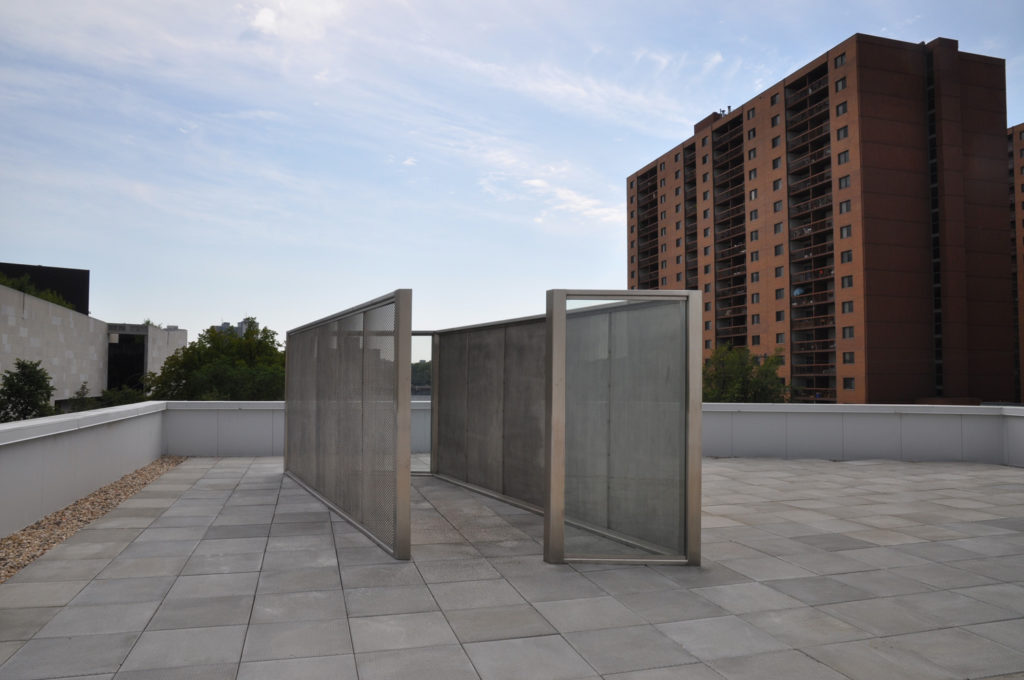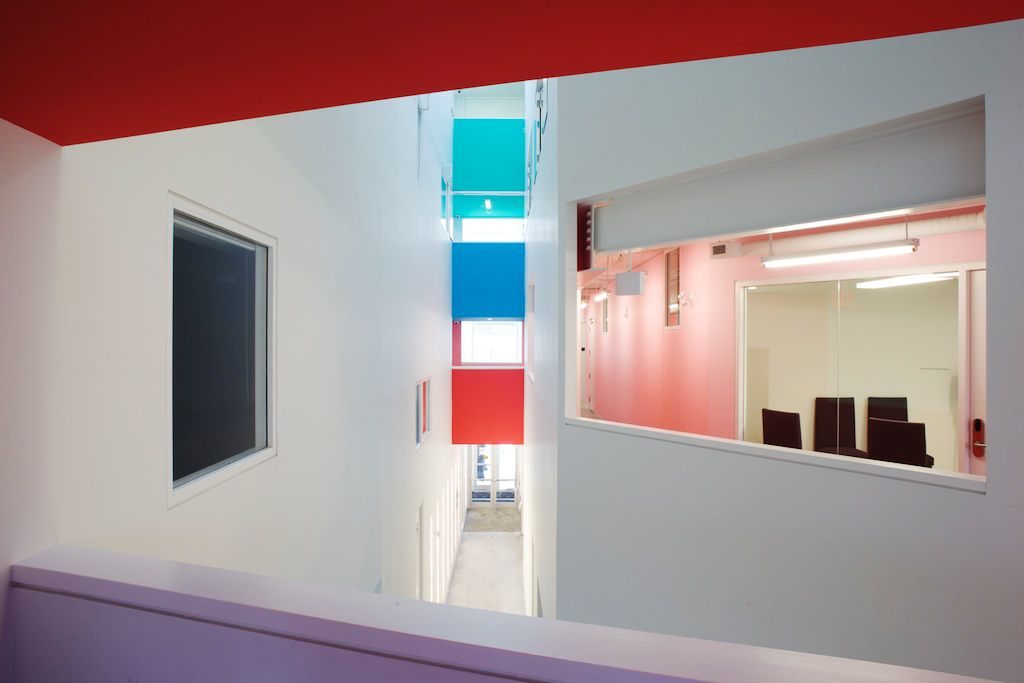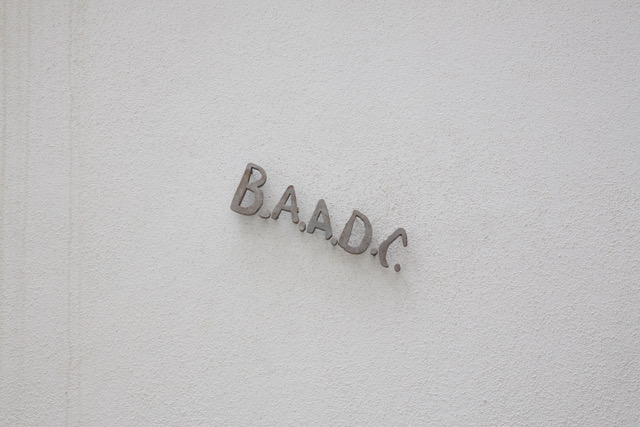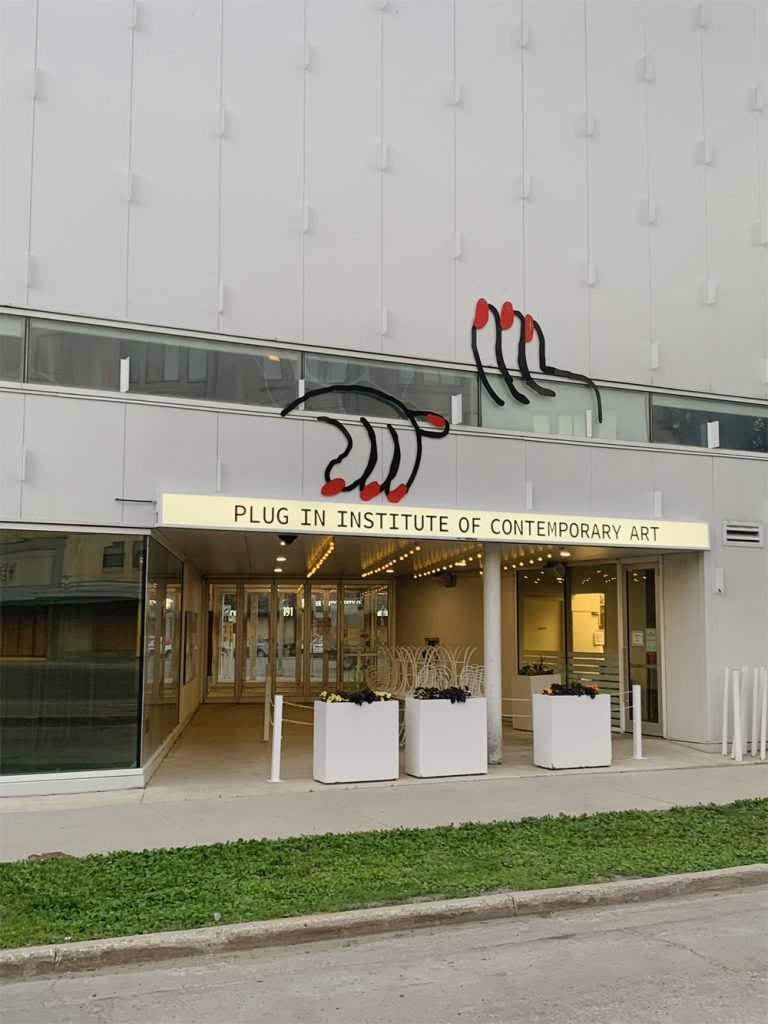Permanent Artworks
Dan Graham
Performance Café with Perforated Sides (2010);
Steel, mirror and glass.
This signature artwork by one of the world’s most renowned artists Dan Graham was created as a permanent installation specifically for Plug In ICA’s roof terrace located on the third floor of the Buhler Centre. This site-specific artwork builds on a legacy of pavilions produced by Graham over thirty years. His Winnipeg pavilion was co-commissioned with the support of the City of Toronto and most generously by Michael F.B. Nesbitt.
Jimmie Durham
Pole to mark the centre of the world (at Winnipeg) (2010), galvanized steel, stainless steel, brass, mirror.
Jimmie Durham is a long-standing artist whose voice has carried significant artistic and political influence. He was a founding member of The American Indian Movement and has had an extensive history of making artwork that considers ideas of nationhood, breaking apart the way national identities are created and represented. In 1995, shortly after Durham moved to Europe, he began to create a series of hand carved poles that would each mark “the centre of the world”. He made the first one for Brussels, a city he described as trying to be the economic and political centre of Europe. Shortly thereafter he made another one for Siberia. In relation to this on-going project Durham has written, “I decided that every continent has seven centres. This is an arbitrary decision—maybe there are eight, maybe there are nine—it doesn’t matter. And every village also has seven centres. For every continent I would make a staff of the seven centres.” This modest yet powerful artwork commissioned by Plug In ICA marks Durham’s second declaration of the centre of world in North America.
In 2017, a controversy emerged with respect to Durham’s claims of Cherokee heritage, claims that he has at times qualified and at other times affirmed as central to his artistic practice and political activity. These claims have not been recognized by the three Cherokee Nations, who as sovereign nations determine their own citizens. Plug In recognizes that there are Cherokee artists and scholars who categorically reject Durham’s claims of Cherokee ancestry, noting that he has neither cultural ties to or sustained engagement with the Cherokee Nations. Plug In stands with the Cherokee Nations unequivocally with respect to their refutation of Durham’s claims of heritage and ancestry. The Institute’s response to this ongoing debate is to foreground it and make it central to any discussion or appreciation of this work, affirming that artworks and the controversies they engender can offer opportunities for frank and respectful discussion and reflection on topics of Indigenous sovereignty and cultural appropriation in contemporary art. These are complex topics that require and deserve public debate, and it is Plug In’s hope that the continued exhibition of Pole to mark the centre of the world (at Winnipeg) engenders this necessary discussion.
Louise Witthöft and Rodney LaTourelle
Untitled (2010), site-specific colour installation.
Specialists in public art, Louise Witthöft and Rodney LaTourelle, apply colour and light to built spaces. Throughout the hallways of the Buhler Centre, over three floors the artists painted varying shades of red, blue and turquoise green. The fluctuating intensity of the colours enhances a dynamic flow to the building’s unique architecture. This work was commissioned by Plug In ICA in collaboration with the building’s architects: DPA+PSA+DIN Collective.
Jean-Paul Kelly
B.A.A.D.C. (2016); water-cut, cold-rolled steel
B.A.A.D.C. takes as its point of departure an image from the French writer and activist Jean Genet’s 1950 film Un chant d’amour – a homoerotically-charged film depicting two prisoners’ struggle for communication and intimacy in a grim cell presided over by a sadistic warden. In the last few frames of the film, the letters “B.A.A.D.C.” appear scrawled in chalk on a cell wall: an abbreviation of the mot de passe: Bienvenue aux amis du calamité (“Welcome, friends of calamity”). This enigmatic message signals welcome and solidarity to the outcast and outlawed. In casting this signal into a steel sculptural work, Toronto artist Jean-Paul Kelly invokes and extends Genet’s gesture of support beyond its historical specifics to address all who face marginalization, exclusion and violence. As Kelly states: “This acronym is a sign to all ‘criminals’ – to queers and all criminalized persons – that this is a place of safe haven.” The location above Plug In ICA’s entrance and the seemingly haphazard hanging of the sculpture, as though hastily scratched into the wall, reinforce the urgency in the work’s message of solidarity and welcome.
Walter Scott
Mary Ann’s Inquiry (2020), router cut 1/4” powder coated aluminium.
Commissioned by Plug In Institute of Contemporary Art in conjunction with their new signage, Walter Scott’s intervention to the façade of the Buhler Centre depicts two manicured hands reaching over the west facing horizontal window. The hands shift between pulling open and propping up the walls of the building—attempting to reshape an institution built on colonial desires of ownership and formalized academic education while making space for art. This uneasy relationship is further accentuated by the manicured nails replicating the red used in the lettering on the Buhler Centre signage, accentuating that we are part of these structures even as we challenge them. Scott writes: “The feminized hand presents itself as a force that perpetually attempts to open things up, and make space for the artists, the marginalized, and the curious.”







